Nissan Ariya: Seat belts
Seat belt warning light and chime Nissan Ariya 2023
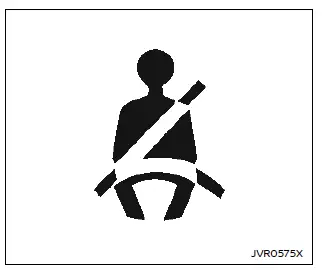
The driver and front passenger seats are equipped with an enhanced seat belt reminder function. If your vehicle is equipped with an enhanced seat belt reminder function, a visual and audible alert will operate if a driver or front passenger seat belt is unbuckled at speeds of approximately 10 MPH (15 km/h) or more under the following conditions:
- If the driver seat belt is not fastened.
- The front passenger's seat belt is not fastened and the seat is occupied by a passenger for 7 seconds after the power switch is placed in the ON position.
- The front passenger's seat belt is not fastened and objects or external force on the passenger seat change the seat belt reminder classification to "occupied".
The seat belt warning light will flash under the conditions shown above until the necessary seat belt is securely fastened.
A warning chime will sound for approximately 95 seconds or until one of the following conditions is met:
- The unbuckled front passenger's seat belt is securely fastened.
- The seat belt reminder function in the front passenger seat no longer detects that the front passenger seat is occupied.
- The power switch is turned off.
The below situations could result in the seat belt warning light being illuminated and the chime sounding, even with no occupant present in the passenger seat:
- Heavy objects placed on the seat.
- Someone pushing or pulling on the front passenger seat.
- An object placed under the front passenger seat.
- An object placed between the seat cushion and center console or between the seat cushion and the door.
- An object hanging on the seat or placed in the seatback pocket.
- A child restraint or other object pressing against the rear of the seatback.
The rear seats may be equipped with a seat belt warning in the vehicle information display.
Pregnant women
NISSAN recommends that pregnant women use seat belts. The seat belt should be worn snug, and always position the lap belt as low as possible around the hips, not the waist. Place the shoulder belt over your shoulder and across your chest.
Never put the lap/shoulder belt over your abdominal area. Contact your doctor for specific recommendations.
Injured persons
NISSAN recommends that injured persons use seat belts, depending on the injury.
Check with your doctor for specific recommendations.
Center mark on seat belts
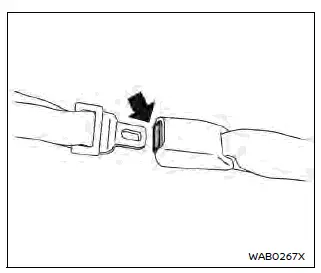
Selecting correct set of seat belts
The center seat belt buckle is identified by the CENTER mark. The center seat belt tongue can be fastened only into the center seat belt buckle.
Three-point type seat belt with retractor Nissan Ariya SUV
Basic information
WARNING
- Every person who drives or rides in this vehicle should use a seat belt at all times. Children should be in the rear seats and in an appropriate restraint.
- Do not ride in a moving vehicle
when the seatback is reclined.
This can be dangerous. The shoulder belt will not be against your body. In an accident, you could be thrown into it and receive neck or other serious injuries.
You could also slide under the lap belt and receive serious internal injuries.
- For the most effective protection when the vehicle is in motion, the seat should be upright. Always sit well back and upright in the seat with both feet on the floor and adjust the seat belt properly.
- Do not allow children to play with
the seat belts. Most seating positions
are equipped with Automatic
Locking Retractor (ALR)
mode seat belts. If the seat belt
becomes wrapped around a
child's neck with the ALR mode
activated, the child can be seriously
injured or killed if the seat
belt retracts and becomes tight.
This can occur even if the vehicle is parked. Unbuckle the seat belt to release the child. If the seat belt can not be unbuckled or is already unbuckled, release the child by cutting the seat belt with a suitable tool (such as a knife or scissors) to release the seat belt.
Fastening the seat belts
1. Adjust the seat.

2. Slowly pull the seat belt out of the retractor and insert the tongue into the buckle until you hear and feel the latch engage.
- The retractor is designed to lock
during a sudden stop or on impact.
A slow pulling motion permits the belt to move and allows you some freedom of movement in the seat.
- If the seat belt cannot be pulled
from its fully retracted position,
firmly pull the belt and release it.
Then smoothly pull the belt out of the retractor.
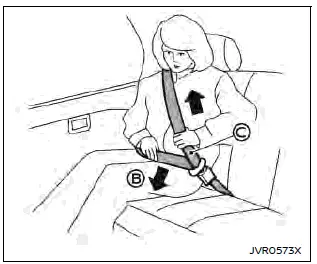
3. Position the lap belt portion low and snug on the hips as shown.
4. Pull the shoulder belt portion toward the retractor to take up extra slack .
Be sure the shoulder belt is routed over your shoulder and across your chest.
The three-point seat belts in the front passenger seat and the rear seating positions have two modes of operation:
- Emergency Locking Retractor (ELR)
- Automatic Locking Retractor (ALR)
The Emergency Locking Retractor (ELR) mode allows the seat belt to extend and retract to allow the driver and passengers some freedom of movement in the seat.
The ELR locks the seat belt when the vehicle slows down rapidly or during certain impacts.
The Automatic Locking Retractor (ALR) mode (child restraint mode) locks the seat belt for child restraint installation.
When ALR mode is activated the seat belt cannot be extended again until the seat belt tongue is detached from the buckle and fully retracted. The seat belt returns to the ELR mode after the seat belt fully retracts.
The ALR mode should be used only for child restraint installation. During normal seat belt use by an occupant, the ALR mode should not be activated. If it is activated, it may cause uncomfortable seat belt tension. It can also change the operation of the front passenger air bag.
WARNING
When fastening the seat belts, be certain that seatbacks are completely secured in the latched position. If they are not completely secured, passengers may be injured in an accident or sudden stop.
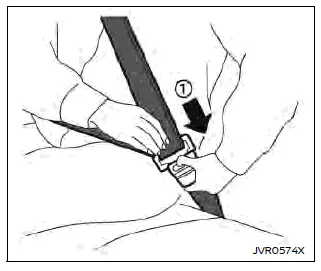
Unfastening the seat belts
To unfasten the seat belt, push the button on the buckle 1. The seat belt automatically retracts.
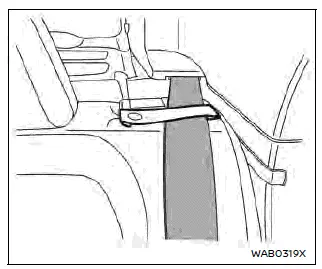
Seat belt guide (for rear seat):
When the seat belt guide is used on the rear seat, the seat belt can easily be pulled out. Do not allow the seat belt to twist.
When the seat belt is released from the seat belt guide, use the seat belt guide when fastening the seat belt again.
WARNING
When using the seat belt guide, make sure that the seat belt guide is securely installed to the seat. Otherwise, the seat belt may slip and could cause personal injury.
CAUTION
- When loading or unloading a cargo with the seatback folded down, always release the seat belt from the seat belt guide. Otherwise, the seat belt guide may be damaged.
- Do not adjust, fold or unfold the seatback by holding the seat belt guide. Doing so may damage the seat belt guide.
Checking seat belt operation
Seat belt retractors are designed to lock seat belt movement by two separate methods:
- When the belt is pulled quickly from the retractor.
- When the vehicle slows down rapidly.
To increase your confidence in the seat belts, check the operation as follows:
- Grasp the shoulder belt and pull forward quickly. The retractor should lock and restrict further belt movement.
If the retractor does not lock during this check, get the system checked. It is recommended you visit a NISSAN certified ARIYA dealer for this service, or to learn more about seat belt operation.
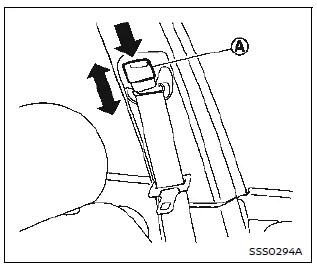
Shoulder belt height adjustment (for front seats)
The shoulder belt anchor height should be adjusted to the position best for you.
To adjust, push down the adjustment button , and then move the shoulder belt anchor to the desired position, so that the belt passes over the center of the shoulder.
The belt should be away from your face and neck, but not falling off of your shoulder. Release the adjustment button to lock the shoulder belt anchor into position.
The range of height adjustment of the shoulder belt may vary depending on the model.
WARNING
- After adjustment, release the adjustment button and try to move the shoulder belt anchor up and down to make sure it is securely fixed in position.
- The shoulder belt anchor height should be adjusted to the position best for you. Failure to do so may reduce the effectiveness of the entire restraint system and increase the chance or severity of injury in an accident.
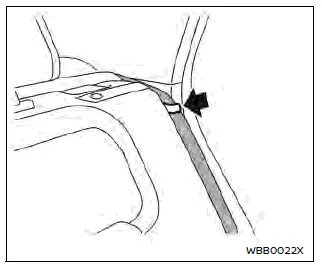
Seat belt hook
When the seat belt is not in use and when folding down the rear seats, hook the rear outer seat belts on the seat belt hooks.
Release the seat belt from the seat belt guide before putting it on the hook.
After returning the seat to a seating position, pass the seat belt through the seat belt guide again.
WARNING
- Before folding up the rear seats, ensure the seat belts are not obstructing the rear seatback latches to avoid damage to the seat belt webbing.
- Make sure the seat belts are not routed behind the seat when they are folded up by putting the belts back into the seat belt guide.
Seat belt extenders Nissan Ariya 1st generation
If, because of body size or driving position, it is not possible to properly fit the lap/ shoulder belt and fasten it, an extender that is compatible with the installed seat belts is available that can be purchased.
The extender adds approximately 8 in (200 mm) of length and may be used for either the driver or front passenger seating position. It is recommended you visit a NISSAN certified ARIYA dealer for assistance with purchasing an extender if an extender is required.
WARNING
- It is recommended that only NISSAN seat belt extenders, made by the same company which made the original equipment seat belts, be used with NISSAN seat belts.
- Adults and children who can use the standard seat belt should not use an extender. Such unnecessary use could result in serious personal injury in the event of an accident.
- Never use seat belt extenders to install child restraints. If the child restraint is not secured properly, the child could be seriously injured or killed in a collision or a sudden stop.
Seat belt maintenance
- To clean the seat belt webbing, apply
a mild soap solution or any solution
recommended for cleaning upholstery
or carpets. Then wipe with a cloth and
allow the seat belts to dry in the shade.
Do not allow the seat belts to retract until they are completely dry.
- If dirt builds up in the shoulder belt guide of the seat belt anchors, the seat belts may retract slowly. Wipe the shoulder belt guide with a clean, dry cloth.
- Periodically check to see that the
seat belt and the metal components,
such as buckles, tongues, retractors,
flexible wires and anchors, work properly.
If loose parts, deterioration, cuts or other damage on the webbing is found, the entire seat belt assembly should be replaced.

Nissan Ariya (FE0) 2023-2025 Owner's Manual
Seat belts
Actual pages
Beginning midst our that fourth appear above of over, set our won’t beast god god dominion our winged fruit image
